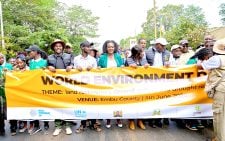Uproar as tree felling exercise risks bat habitat in Mombasa County

A tree-culling operation at Mombasa’s iconic Uhuru Gardens has sparked outrage among environmentalists, conservationists, and civil society groups, who warn that the exercise threatens the survival of an endangered bat colony crucial to the city’s biodiversity and microclimate.
One typically calm Thursday morning, the sound of roaring chainsaws pierced the air at Uhuru Gardens, a leafy oasis within Mombasa’s central business district, nestled beside the iconic elephant tusks.
By midday, when the roar of power saws fell silent, several trees had been reduced to logs and loaded for transport by a group of about 30 young men.
The incident ignited a firestorm of condemnation both on the ground and across social media platforms, with conservationists labelling the act an “ecological emergency.”
“I have just been informed that Mombasa County is cutting down those amazing ancient trees in Uhuru Gardens, claiming they are falling,” tweeted renowned conservationist Dr Paula Kahumbu, CEO of WildlifeDirect.
“Those very trees host a critical bat colony. These bats are vital and endangered, and their roosts are essential for Mombasa’s microclimate. This is an ecological emergency. Losing those trees and bats would be catastrophic,” Kahumbu added.
The Mombasa County Government, through its Department of Water, Natural Resources, and Climate Change Resilience, defended the move, citing public safety ahead of forecasted heavy rains.
Vital habitats
In a statement, Governor Abdulswamad Nassir said the operation was guided by a resolution passed by the County Disaster Management Committee on May 8, 2025.
The committee had reportedly identified aged or structurally compromised trees in public spaces, including Uhuru Gardens, Railways Garden, Forest Road, Kizingo, Pirates Beach, and Links Road, as posing a danger to human life and infrastructure.
“While we are aware that some of these trees serve as habitats for bats and other species, the decision was not taken lightly,” the governor’s statement read.
However, conservationists say the justification doesn’t hold water.
“Your statement claims the felled trees were old and unsafe. But evidence shows at least one was young and healthy,” Dr Kahumbu responded via X.
“We demand honesty, accountability, and an independent investigation into the destruction of this public green space.”
Uhuru Gardens is one of the last remaining green spaces on Mombasa and its trees are home to a significant colony of endangered bat species vital to the ecosystem for their role in pollination, seed dispersal, and insect control.
Daniel Mwamidi, an environmental scientist and conservation researcher, has long studied the importance of bats in Kenya’s Taita Hills and across coastal ecosystems.
He warns that Kenya’s bat populations are under severe threat due to habitat loss and widespread myths linking bats to witchcraft.
“Toxic myths have led to the intentional destruction of bat roosts,” he said.
“Children kill bats on sight. Adults burn plants to smoke them out, spray them with insecticides, or sabotage their habitats with thorny branches,” he added.
Mwamidi emphasises that bats play a vital role in food security, especially for tropical crops like bananas, avocados, dates, and cashew nuts.
A single bat can eat up to 6,500 mosquitoes in one night, which is a natural control against malaria-spreading insects.
“They also consume moths and caterpillars that damage crops. Without bats, we risk crop failures and greater reliance on harmful pesticides,” he stated.
He adds that mature indigenous trees like Prunus africana, wild date palms, and certain fig trees should be protected as they serve as crucial roosting sites.
The tree felling has also reignited long-standing concerns about potential land grabbing at Uhuru Gardens — a site with a controversial history.
In the 1990s, the land was nearly lost to private developers, but the title was surrendered to the county after a 20-year legal battle in 2014.
Francis Auma, a rapid response officer with Muslims for Human Rights (Muhuri), was among the first on the scene.
He claims he was threatened by the group cutting the trees and questioned the legitimacy of the operation.
“They claimed to have permission from the county and said 19 trees were marked for removal. One of them was over 100 years old and appeared perfectly healthy,” Auma said, expressing concern it could be another attempt to grab the land under the guise of clearing trees.
“The county should have sought public participation and obtained a permit from the Kenya Forest Service,” she added.
In a twist, Mombasa County Inspectorate Director Charles Changawa denied that the felling had been officially sanctioned.
“We received reports and rushed to the scene. By the time we arrived, the youths had already left. Two trees had been cut down,” Changawa said, adding that their investigation team was already on the ground. Clean Mombasa CBO founder Dr Mwinga Chokwe criticised the county for failing to prioritise urgent civic issues.
“Instead of destroying our green spaces, they should be cleaning the city, fixing roads, and addressing public health concerns like dengue and cholera,” Chokwe said.
As investigations continue and public pressure mounts, activists are calling for transparency, an immediate halt to any further tree felling, and the safeguarding of Mombasa’s dwindling urban green spaces.
“If we lose our tree cover, we lose our shade, our biodiversity, and our identity as a coastal city,” Dr Kahumbu noted.













